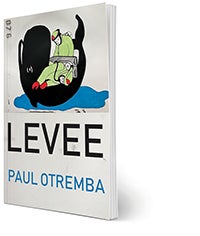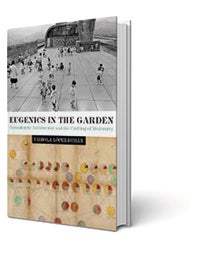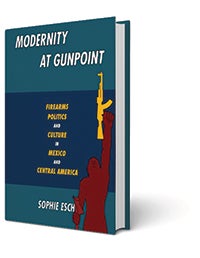Faculty Books
Fall 2019

Levee
Paul Otremba
Four Way Books, 2019
Paul Otremba’s third collection of poems, “Levee,” was published posthumously in September. An assistant professor of creative writing at Rice, Otremba died of cancer in June at age 40. Otremba and his vivid poetry, too, were inspired by both Houston and Rice. “Living in Houston for the past 14 years, I have gone through three major hurricanes and two devastating floods,” he told New England Review poetry editor Rick Barot while discussing his poem “Like a Wide River” in an interview last year. The poems in “Levee” confront ecology, politics and illness, in what Otremba described to Barot as “what is owed, what is gathered, what is a flood of indignation, anger and grief.” Otremba also formerly served as the poetry editor for Gulf Coast: A Journal of Literature and Fine Arts. He published widely in journals, including Kenyon Review, New England Review, Literary Imagination and Southwest Review. His essays, poetry reviews and food writing appeared in Tikkun, the Houston Chronicle, Spoon Magazine and the anthology “American Poets in the 21st Century: The New Poetics.” “Paul’s extraordinary poetic talent made him a crucial member of the faculty and a key contributor to the creative and critical components of our curriculum,” said Rosemary Hennessy, the L.H. Favrot Professor of Humanities and English department chair. “His poetry courses were much sought after and he was especially beloved by the students in his advanced poetry classes. We will miss him intensely.” — Katharine Shilcutt
The Dance
by Paul Otremba
What should have been the vision
stretching before the curve?
What could I have done
for insight? It’s a tale
of dirt. Of things
unplanned for rising
from the stone planter.
I look in the mirror
and trace the scar—
a fallen shepherd’s crook,
a dropped question—
and my finger
makes a double seeing,
working along my skin.
What should the response have been?
Where does the fear fall
if the pit is pure
absence? I always suspected
intuition was the bowel’s game.
Feeling is a snake’s
skin, not a cup.
We danced in the living room
to Richie Havens’s “Follow,”
my eyes sloughing off
whatever self I had erected.
It was more like holding you
inside a tightening circle
while around us a circle moved.
“The Dance” from “Levee” © 2019 by Paul Otremba. Appears with the permission of Four Way Books. All rights reserved.

Eugenics in the Garden
Transatlantic Architecture and the Crafting of Modernity
Fabiola López-Durán
University of Texas Press, 2018
Fabiola López-Durán, an associate professor of art history, traces how the “science” of race improvement spread from medicine to architecture. She also details how Latin American elites pursued utopian urban modernization projects under the influence of eugenics at the turn of the 20th century. “The book focuses on the very clinical agenda that brought the human body to the center of modernist ideology, examining the complicity between science and aesthetics used to ‘normalize’ a so-called feeble population in Latin America,” she said in an interview published in Rice News. “In doing so, it reveals how eugenics, in its striving to create a new ‘human ideal,’ found in medical science a moral guidepost through which architecture, urbanism and landscape design became its primary technologies.”
Earlier this year, the book won the 2019 Robert Motherwell Book Award, which is awarded to the author of an outstanding publication on the history and criticism of modernism in the arts. “I hope people see the timely nature of this book and reflect on the key assertion that the book makes: Race constructs space, and space in turn constructs race. The global refugee crisis and other politically charged forms of segregation here and abroad makes it very clear that we are not living in a post-racial society, and that we need to understand the interactions of space and power by which race is instrumentalized.” — Katharine Shilcutt

Modernity at Gunpoint
Firearms, Politics and Culture in Mexico and Central America
Sophie Esch
University of Pittsburgh Press, 2018
Think of the Mexican Revolution and you may picture the iconic image of Emiliano Zapata, his chest crossed with cartridge belts, defiantly holding a rifle aloft. There’s a reason firearms feature heavily in the revolutionary images, songs and writings of the time; even Zapata’s provocative pose would hardly make an impression without all the weaponry. As a symbol of power, Sophie Esch notes in “Modernity at Gunpoint,” guns are hard to beat.
“For decades, peasants had been marginalized within Mexico’s feudal-capitalist system and repressed by authoritarian elites,” writes Esch, an assistant professor of Mexican and Central American literature and culture. “But with rifles in their hands, they could no longer be ignored.” Esch’s cultural analysis of gun imagery in Latin American literature and arts extends from the Mexican Revolution to the Sandinista Revolution and the seemingly endless drug wars that plague these regions. While previous scholars of Latin American conflicts have largely ignored this imagery, Esch stares down the barrel of what she considers “the object that most clearly encapsulates the violence inherent in projects of modernity.” — Jennifer Latson

The Desert Speaks to the Dreamer
Deborah Barrett ’83
Finishing Line Press, 2019
There are ghosts in Deborah Barrett’s poetry. In this collection of poems linked by loss — through death, divorce, extinction and natural disaster — Barrett, a professor in the practice of professional communication, pays homage to those who are no longer with us and considers the way we carry their memories as we make our haunted way in the world. She doesn’t let the darkness overwhelm, however; her verse points to hope as a guiding force through grief.
“This is a poetry that mourns the fleeting world — the death of a parent and the death of a species, the loss of a house to floodwaters and the loss of a child to adoption — with an eye for crystalline detail and a sure sense of formal possibility,” writes fellow poet Peter Kline. “Yet the emotional resonance of these fine poems goes far beyond simple lament; they chronicle and question and celebrate even as they weep.” Loss, after all, is a part of life, and Barrett observes the joys of the human experience even as she mourns our mortality. “Being is surviving,” she writes in her poem “Death Waits,” “despite the deep pain of / loss and despair.” — J.L.
The Magic Carpet
by Deborah Barrett
Where it takes you is beyond
the mundane, the ordinary.
Words emerge from notebooks or
scraps of paper or computers to be
interwoven into lines like woolen fibers
that create the ride of the imagination.
The escape into the beauty
of language elevates, clarifies, and
makes meaning deeper through
the metaphors and symbols of life.
Poetry floats above making the world
better because of its existence.
Used by permission of the author.
